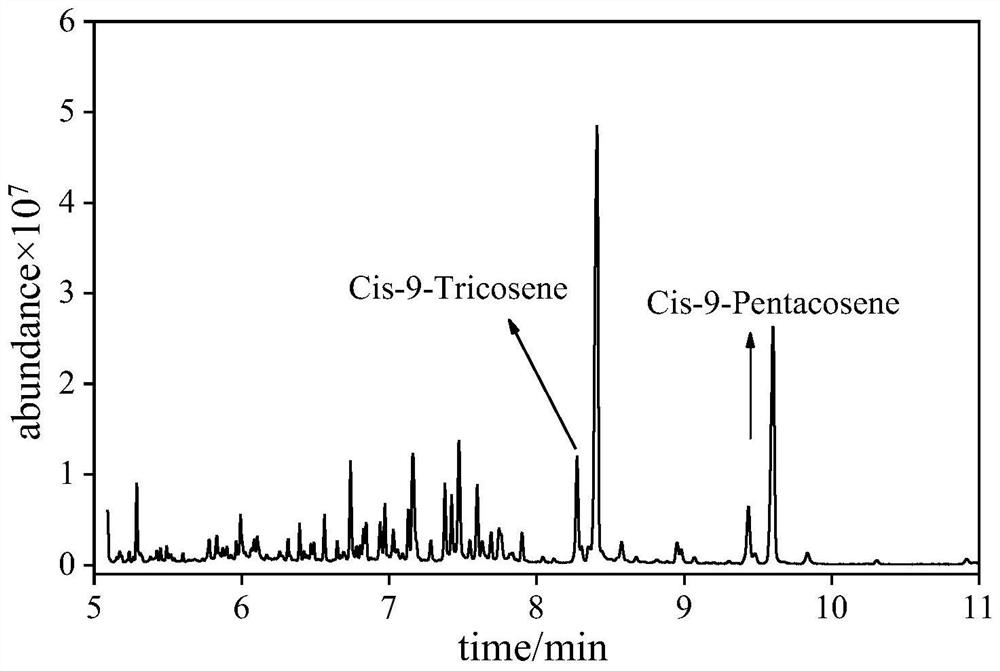Method for distinguishing Apis cerana cerana honey from Apis mellifera ligustica honey
A honey, Italian bee technology, applied in the field of biochemistry, can solve the problems of brand image and enterprise loss, low production of honey in China Bee, and unfavorable development of the bee product market.
- Summary
- Abstract
- Description
- Claims
- Application Information
AI Technical Summary
Problems solved by technology
Method used
Image
Examples
Embodiment 1
[0072] Discovery of the key difference substances between bee honey and Italian bee honey in embodiment 1
[0073] Sample source:
[0074] A total of 50 common real honey samples were collected from beekeepers: 40 of which were Italian bee honey, including 10 acacia honey, 10 jujube honey, 10 wattle honey, and 10 linden honey; Chinese bee honey (earth honey) 10.
[0075] Experimental steps:
[0076] Weigh 2.0 g of the honey sample into a headspace bottle. Placed in an automated headspace solid-phase microextraction device to extract and enrich honey samples, the solid-phase microextraction fiber used was 30 μm PDMS, the extraction temperature was 60°C, the extraction time was 30 minutes, and the equilibration time was 5 minutes. The analysis time is 5 min; use GC-MS for detection.
[0077] The detection conditions of GC are:
[0078] Chromatographic column: DB-5MS capillary column;
[0079] Temperature program: initial temperature 50°C, keep for 1min; then rise to 250°C ...
Embodiment 2
[0099] The optimization of the identification method of bee honey and Italian bee honey in embodiment 2
[0100] Sample source is with embodiment 1.
[0101] The experimental conditions such as extraction temperature and extraction time were further optimized, and the quantitative method of matrix working curve was determined.
[0102] 1. Optimization of extraction temperature
[0103] Take 2g of Italian honey in a 20mL headspace bottle, and perform SPME extraction and GC-MS detection at 40, 50, 60, 70, and 80°C, respectively.
[0104] The experimental results showed that as the extraction temperature increased, the peak areas of the target C9T and C9P gradually increased, but when the temperature was higher than 70°C, the nutritional components of honey might change, and too high a temperature would cause fiber damage. However, the higher target response at 60 °C can meet the detection requirements, so the selected extraction temperature is 60 °C.
[0105] 2. Optimization ...
Embodiment 3
[0121] Embodiment 3 Actual sample detection and Chinese bee honey identification
[0122] Sample source:
[0123] Fifteen batches of honey samples identified as "earth honey" or "China bee honey" were purchased from offline supermarkets and online platforms.
PUM
 Login to View More
Login to View More Abstract
Description
Claims
Application Information
 Login to View More
Login to View More - R&D
- Intellectual Property
- Life Sciences
- Materials
- Tech Scout
- Unparalleled Data Quality
- Higher Quality Content
- 60% Fewer Hallucinations
Browse by: Latest US Patents, China's latest patents, Technical Efficacy Thesaurus, Application Domain, Technology Topic, Popular Technical Reports.
© 2025 PatSnap. All rights reserved.Legal|Privacy policy|Modern Slavery Act Transparency Statement|Sitemap|About US| Contact US: help@patsnap.com



